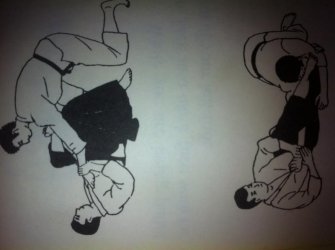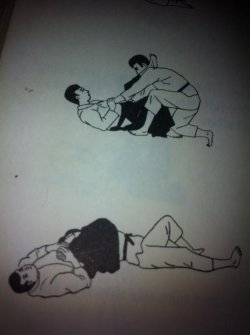Okay, this might take a bit... I'm going to split it into the "ninjutsu" questions and statements, and the BJJ/Judo origins part...
That's not "ninjutsu using BJJ", though. It's the AKBAN organisation (a Ninjutsu/Bujinkan based organisation, headed by Yossi Sherif, former student of Doron Navon), and a big part of what they do is to attempt to document the various arts that have gone into the make-up of their teachers backgrounds (albeit with one or two other things...). In this case, you need to know that Doron Navon was also a Judoka, and taught his Judo methodology alongside the "Ninjutsu" portion of his syllabus (that's the thing here, mate, this ain't BJJ, it's Judo. Similar? Definitely. The same? Definitely not). Doron also taught Feldencrais... does that mean that the movement and postural work is part of Ninjutsu? Nope, not in the slightest.
But really, if you're going to post such clips, take a moment to read the comments, where Yossi states pretty clearly that this is from Judo, not BJJ, that it's not part of any of the schools of the Ninjutsu side (here's some free information for you.. in the "Ninjutsu" schools, what's taught is really only called "Ninjutsu" for convenience... it's actually a number of Japanese arts, namely Shinden Fudo Ryu Dakentaijutsu [and Ju(tai)jutsu in some cases], Kukishinden Ryu Happo Biken [Dakentaijutsu and a large Bukijutsu syllabus], Hontai Takagi Yoshin Ryu Ju[tai]jutsu, Togakure Ryu Ninpo Taijutsu [one of the smallest, and the primary source of any actual "ninjutsu"], Gyokko Ryu Kosshijutsu, Koto Ryu Koppojutsu, and so on), and is really only there as part of an attempt to document the myriad techniques found in all the arts taught there, Judo being one of them.
This, by the way, is the definition of "fail" when it comes to recognizing what a martial art is.
No, they state that they also teach BJJ/Judo, not that they "openly admit to using techniques from BJJ". And, as I already said, yes, there are some teachers who are teaching both Bujinkan and BJJ... or training in both. And there are others who have used BJJ to help inform their ground work... but that's not the same as "incorporating" BJJ into Ninjutsu. Your logic is flawed, and you aren't listening to any correction.
Well... the WWE doesn't do BJJ, but Mark Calaway (the Undertaker) does. He holds a black belt under Rolles Gracie. Other WWE performers have trained, or continue to train in it as well, such as Eve Torres and CM Punk.
While there are certain differences between the Akban group and other organisations, it's not quite the same as that... but that's getting way off topic.
Firstly, again I'd suggest what's written on the clips you post... there's a mix of both Japanese and English terminology... but I noted absolutely no Portuguese. Hmm.... Frankly, the usage of the English is because it's aimed at a large audience, so simple, easily identifiable and recognizable language is used. If Do Jime or Do Sae was listed, would the larger audience know what they were? Additionally, as I just showed by using a different (Japanese) term, specific names are particular to specific systems/arts... there is no such thing as a singly used and adopted terminology. Using a "common language" is simply a way to get more people identifying what they're seeing and being able to relate to them.
Again, mate, read the comments... there is mention that the head instructor trained in both Bujinkan and BJJ. And, again, I personally brought up instructors in the Bujinkan (Simon Yeo) who teach BJJ alongside the Bujinkan material... so? Richard Van Donk also teaches a line of Escrima/Kali that he has... does that mean that Ninjutsu has Kali in it? I mean, I also know of other Bujinkan students who train in other forms of Kali as well...
I will say this. Despite claims from certain circles, there is no ground fighting in any of the arts of the Bujinkan. There are Kime Waza/Osai Komi, and there is Suwari Waza, but there is no ne waza. So, should a particular dojo want to look at ne waza, I'd recommend they look to either Judo or BJJ. We don't have any. Why not? Because it has no place in the contexts and historical realities of our systems. There's also no ne waza in any of the Koryu I study either... should they have some, do you think? Here's a clue - the answer is no.
Er... and? Are you trying to imply that the only way anyone can win via submission is by using BJJ? Seriously? Not familiar with Judo, Kansetsu waza, Osai Komi, CaCC Wrestling, Greco-Roman, Freestyle, or any of a large number of other forms? You do realise, of course, that although there is no traditional ground fighting what are called the Ninjutsu systems, they are Japanese arts, which makes them grappling-oriented almost by definition (note here: grappling does not, nor has it ever, refer to ground fighting. That is a gross mis-application of the term by modern ground fighters)? Japanese arts aren't striking arts... they're all about catching, holding, pinning, choking, locking, throwing... and you're thinking that someone with a Japanese art background getting people to submit shows a dominance of something he hadn't trained in? Really?
I mean, let me ask you something... is this BJJ?
View attachment 18463
How about this one?
View attachment 18464
The answer is that, no, they're not. They are Tengu Gaeshi and Tengu Otoshi (respectively) from Asayama Ichiden Ryu Taijutsu... from the late 16th/early 17th Century. And, for the record, this is something that is found in the Ninjutsu schools (Hatsumi learnt it early on, and Tanemura [head of the Genbukan] currently holds the position of head of the Ryu in a line of it).
And, yes, Scott was a black belt under Mike... who is Bob's brother. Your point? Oh, and I'm really not the person to inform about the history of RBWI or anything related, for the record.
Hope you do. And yeah, it had some length... but still far from a record for me, ha!
1: Kano's goal was absolutely not to "make Judo an Olympic sport".
2: Even if true, that would in no way make Judo less or more traditional... the idea that BJJ (Gracie variant) and it's goal of a "practical fighting system" makes it more traditional is completely irrelevant. RBSD systems are even more concerned than BJJ is for creating practical fighting systems, with absolutely no competition aspect at all...and they aren't traditional in the slightest. The benchmarks you're applying aren't accurate at all.
Ground grappling does not equal BJJ. Most of their ground work comes from Doron Navon's Judo background. And, if you ask them, they will tell you that they're still part of the Bujinkan... there actually aren't any restrictions on what an instructor or group within the Bujinkan can or can't add to their syllabus.
No, it's a group of Ninjutsu-based schools within the Bujinkan fold (oh, and for the record, "ninjutsu", never "ninjitsu"... there are reasons...)
Sure, it isn't... but the term is used because listing "Jujutsu, Dakentaijutsu, Taihenjutsu, Kenjutsu, Bojutsu, Hanbojutsu, Sojutsu, Jojutsu, Jutte, Kodachi, Taijutsu, Ninpo, Naginatajutsu, Bisentojutsu etc etc etc", or "Togakure Ryu, Shinden Fudo Ryu, Hontai Takagi Yoshin Ryu, Kukishinden Ryu, Gyokko Ryu, Koto Ryu, Gikan Ryu, Gyokushin Ryu, Kumogakure Ryu" just takes too damn long to say...
Yes they do. Because the bulk of what they do comes from Doron Navon, the first non-Japanese to be awarded a teaching licence in the Bujinkan. But it's not the only thing they do.
Ah, now that opens up a whole grey area...
Yes and no. While there certainly is a lot of freedom, and personal exploration is encouraged, there are still quite a number of traits and concepts that are found throughout the art and it's practice. What are these principles? Well, it'll depend on what exactly you're looking at... but, in essence, you'll see a lot of evasive movement, subtle usage of angling and distancing, particular approaches to targeting, fluid actions, complete body movement rather than isolated parts of the body, and so on. It also has incorporation of weapons into a lot of "unarmed" approaches.
No, I'd say that if you joined that school you'd learn some aspects which are part of what is found in BJJ. I mean, if you learnt only two stick drills from Kali in amongst a deeper, wider study of karate, are you also learning FMA? Or are you learning something, an aspect, that draws from FMA? Semantics, maybe, but important, I feel.
No Ninjutsu school that I have ever come across is actually incorporating BJJ into their "style". It's simply not possible, really. It can be incorporated into the school, but that's another situation entirely.
And, frankly, impossible. To do so would be to create something that was neither Ninjutsu nor BJJ.
From a technical standpoint, the base of Judo is Tenjin Shin'yo Ryu (Kano had two teachers of that system, Fukuda Hachinosuke first, and Iso Masatomo second), and Kito Ryu (under Iikubo Tsunetoshi) with Fukuda and Iikubo having a preference for randori (free training), which helped shape the young Kano's approach to his development of Judo. The ne-waza is based primarily in the Tenjin Shin'yo Ryu, but got a lot more developed when Mataemon Tanabe was brought in as a guest instructor (Tanabe, as a smaller person, realized early that his best defence against the larger opponents in his randori training throwing him was to drop down and pull the opponent down as well, fighting from there. Despite Tanabe being the then-head of Fusen Ryu, the ne waza he employed was almost purely from his randori exploration, not Fusen Ryu itself).
Not really... Maeda was a Kodokan member, sure. But that's not the whole story either. He was also pretty much what we'd class today as almost a professional wrestler... there was a range of other influences in what he taught. And from what I've seen, he hardly gave the full Kodokan syllabus... at best, he gave a form of Judo in it's infancy, mixed with a few other things, and skewed towards working on the ground.
Except that's not right either. For one thing, there's no such single art as "jujutsu". You need to trace it back to specific systems of Jujutsu... if we go back via Tenjin Shin'yo Ryu, we go back to Yoshin Ryu (Akiyama Yoshin Ryu), which was based on three primarily striking techniques brought back by Akiyama from China, extrapolated and developed into an expansive grappling method. Kito Ryu traces back to the Yagyu family, who taught Yagyu Shinkage Ryu... which goes back to Shinkage Ryu, then to Kage Ryu... all of which are sword systems.
You really need to recognise which Jujutsu you're talking about...
Well.... the early name for Judo was simply Kano-ha Jujutsu, so was Maeda taught Judo or Jujutsu? And is there a difference? Honestly, the answer is no, Judo is Jujutsu... it's just one form of it.
Damn straight, it is!
Yeah... I tried to address that a few pages back... didn't seem to take....


